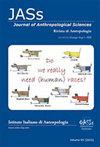Race and racism in France.
IF 2.3
2区 社会学
Q1 ANTHROPOLOGY
Journal of Anthropological Sciences
Pub Date : 2017-12-30
Epub Date: 2017-07-10
DOI:10.4436/JASS.95009
引用次数: 1
Abstract
The Musée de l’Homme in Paris, has chosen for his first big temporary exhibition after reopening in October 2015, to address the question of racism. The exhibition is entitled: Us and them – from prejudices to racism (http://nousetlesautres.museedelhomme.fr/en). I am the scientific commissioner with my colleague Carole Reynaud-Paligot, an historian. What is racism? Why does it exist? Are all humans racist? In recent years, social psychologists, geneticists and researchers in the humanities and social sciences have explored issues relating to alterity and racism. This exhibition draws on their research and more, from France and throughout the world to produce an original analysis of the phenomena of racialization, both in the past and today, which emphasizes not only the widely known facts but also how these phenomena were constructed. Before answering the questions raised by Alan Goodman, it is important to situate racism in France. French racism is not limited to biological-racism i.e. racism based on the idea of races defined by biological criteria. Indeed, biologicalracism is one of the different forms of racisms that exist. This goes back at least to XXth century history: after the second world war, Anglo-Saxon countries (primarily the UK and USA) focused on the question of discriminations in relation to skin color, while in France anti-racism was mostly taken care of by different associations who have been created to fight anti-Semitism (see the work of Bleich, 2003). So that when we talk about racism, it is not limited to biological-racism, but includes racisms based on culture or religion that are also “essentialized”. Therefore we have chosen the following definition for racism: “being racist is to regard the differences between individuals, be they physical, cultural or moral, as hereditary, immutable and “natural”. Racism establishes a hierarchy of categories of human beings, and this can lead to practices ranging from discrimination through to extermination.” This definition encompasses different form of racisms either based on a biological or a cultural criterion. Our definition is based on three key components: categorization, hierarchization and essentialization. Categorization is a mental operation that simplifies the world. People classify individuals based on their appearance, their religion, their geographical origin, etc. The criteria used to differentiate people vary according to the particular society and period. Such “categories” are neither natural nor fixed. Hierarchization involves a value judgment based on regarding one group or category of individuals as being superior or inferior to another. Essentialization is a process by which individuals are reduced to moral characteristics, intellectual faculties or psychological traits alleged to be an immutable and inherited feature of that particular group. Having presented the stage for France, the following directly address the questions posed by Alan Goodman.法国的种族和种族主义。
本文章由计算机程序翻译,如有差异,请以英文原文为准。
求助全文
约1分钟内获得全文
求助全文
来源期刊

Journal of Anthropological Sciences
Social Sciences-Anthropology
CiteScore
2.20
自引率
5.60%
发文量
7
期刊介绍:
The Journal of Anthropological Sciences (JASs) publishes reviews, original papers and notes concerning human paleontology, prehistory, biology and genetics of extinct and extant populations. Particular attention is paid to the significance of Anthropology as an interdisciplinary field of research. Only papers in English can be considered for publication. All contributions are revised by the editorial board together with the panel of referees.
 求助内容:
求助内容: 应助结果提醒方式:
应助结果提醒方式:


